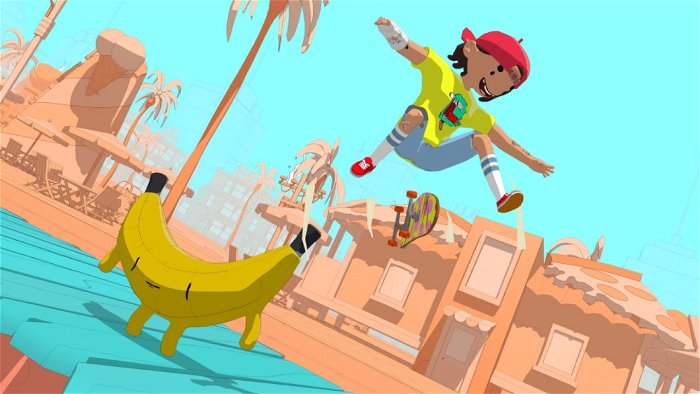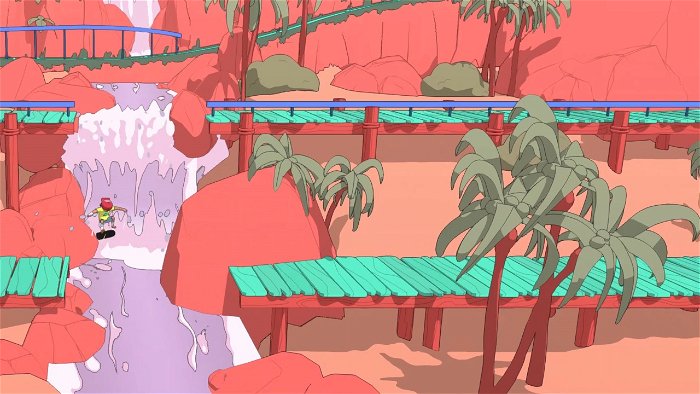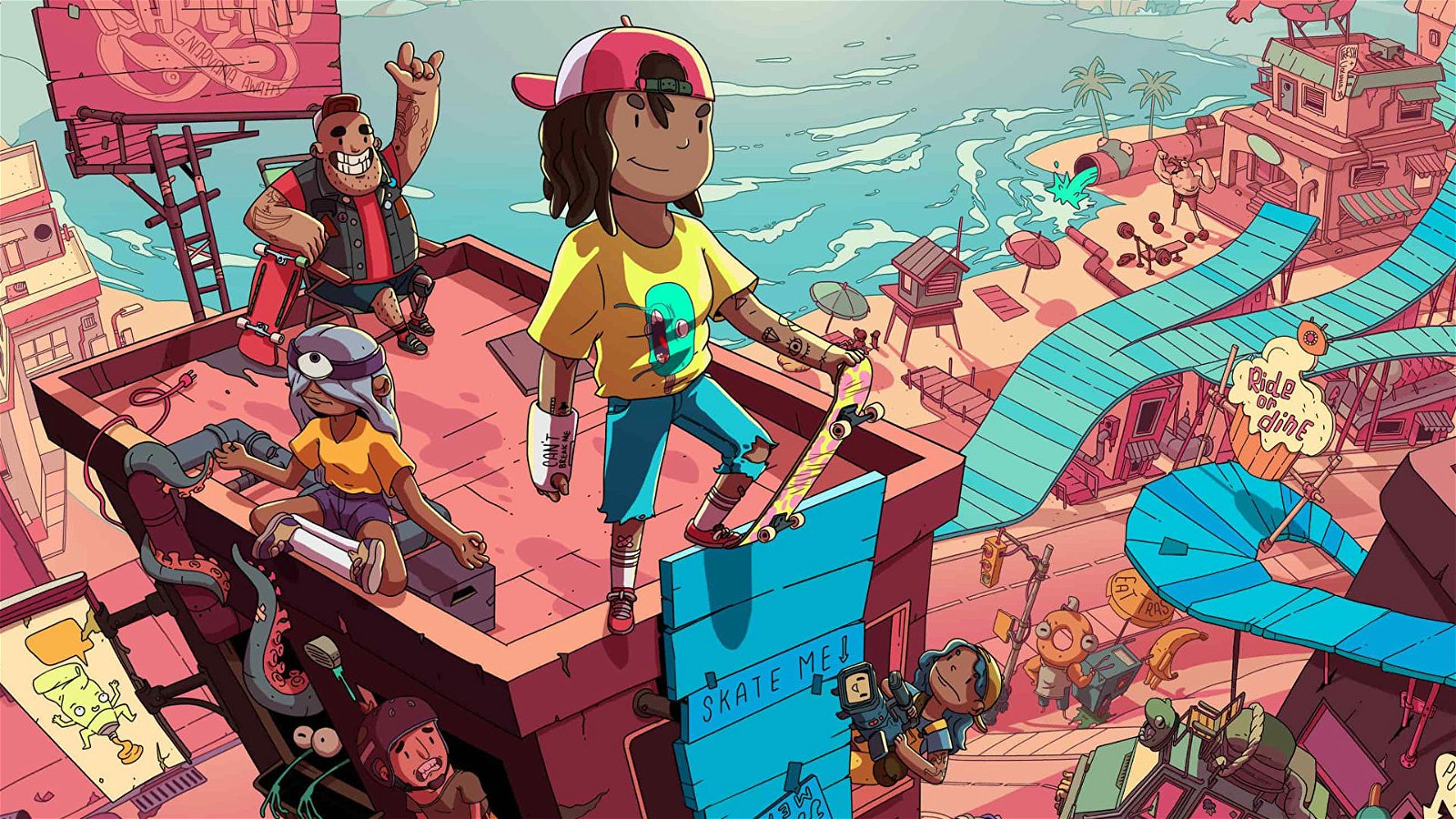OlliOlli is the cult arcade-style skateboarding game, known for its unique style and punishing difficulty. Created by the award-winning, London-based Studio Roll7—and published by Devolver Digital, the finest purveyors of indie games—the series best exemplifies the studio’s philosophy of “Flow State Gaming,” getting players to find their grooves and go for big scores, or crazy combos.
With their newest entry in the series, OlliOlli World, taking a much more different look and approach to gameplay; CGMagazine took some time to sit down with Creative Director John Ribbins to talk a bit about the making of OlliOlli World—it’s new-found style, it’s wacky world, and the joy it can bring to a life still in the grips of a pandemic.
CGMagazine: Why the choice to move from a mobile gaming—or a really accessible handheld type experience—into something that is much more fleshed out and more realized?
John Ribbins: We started on Vita; so, there was a technical limitation to what we could do, right? And, we were six people in an office in Deptford, and we’d never made a commercial game before. So that was…we don’t like client work and stuff like that. But honestly, when we showed the original prototype to Sony, and they were like, “you want to put this on the Vita?” And we were like, “yeah, that’d be great! We should go and buy a Vita, because we’ve never even played one.” It took us three months to draw one pixel to the top left-hand corner of the screen, just to figure out like how to render stuff.
“When we started doing OlliOlli one on the Vita, you couldn’t build for Vita on Unity.”
So, when we started doing OlliOlli one on the Vita, you couldn’t build for Vita on Unity. So we had to code everything from scratch. The first few games were growing as a studio, we were trying to build stuff that we know we could finish, that we know is within our technical expertise and scope. And then honestly, we took a break for a long time, we deployed it to a bunch of other platforms. So we gained some experience and we’ve done a bunch of other games in the interim.

CGMagazine: You did Not A Hero, correct?
John Ribbins: We did Not a Hero lately. And then we had a break, and we were like, “what do we want to do next?” I think we’d come full circle from being like, “we’re done with skateboarding,” to being like, “you know what? All the things we’ve learned in the five years since we last did OlliOlli, we can probably make the one back when we had that first opportunity, right? So being able to go like, “man, it could be 3d, it could be more open, we could have like, customization; we could have like, multiple branching paths, and quests.” And we can probably do that now, and—fingers crossed—not mess it up.
And also, it’s a chance to finish some unfinished business. We made the first two games in an era when really hard games were cool. We wanted to go: It’s neat, Dark Souls on a skateboard, right? Which was a positive and people were like, “yes, punish me.” I think now people are like, “I got a lot of going on, I just want to play something.” We probably need to make a little more accessible for a lot of people, right? And so, then I was like, “can we do it justice? Can we do a bigger, better, shiny thing that we always wanted to do? Can we make it more accessible and more fun for more people?” I think those were the two main starting points.
CGMagazine: I noticed the visual style has changed a lot this instalment. You’ve really found a unique voice with the look. How did that come to be?
John Ribbins: So, obviously, Not a Hero is pixel art, but Not a Hero is a lot of fun because it was silly. We’re making up this real world, we have weird characters and whatever; it was fun. Developing that game was fun because it’s got this weirdness to it. We want to really have more heart. We want the world to have more character, we want there to be people you meet, we want it to be a fun place to be.
And creating your own world for the game to take place in with its own population and its own lore, and its own locations, gives us lots of freedom to be creative. If we want there to be a character, like a talking fish inside a big rectangle of glass; we can do that—because when I go out, no one can say that can’t exist, right? And that freedom is really nice, it gives us like a lot of space. We went through a bunch of different obstacles. We wanted to look like a skate cartoon—like you’re almost watching an animated show about skateboarding. We did go through a lot of iterations, like looking at styles…you know, Gorillaz, the band? Really edgey, angular stuff like that. We iterated on a bunch of stuff, we settled on that sort of gloopy, and round blobby. This feels warm, cuddly, welcoming—and I think when things start to pull together, and people start vibing on the stuff that’s being created; that’s where it comes together.

CGMagazine: Seeing a game of this nature—a skateboarding game—especially when so many people have been stuck inside for close to two years now is a bit unique. What’s that like making a game that is about being out being enjoying the outside, being around other people, when no one can do that presently?
John Ribbins: If you love football, you couldn’t play football last year. But you could go to the parking lot down the road, and do some flips like that. And weirdly, I think a lot of people got back into skate because it was like, “oh, I can actually go to do that on my own and do the thing that I remembered from when I was 14!”
That was definitely an element over the course of development. A bunch of people who are on the game because I think people were like, “oh yeah! The game’s fun. I remember this being fun, I’m gonna go and do it!”
The world’s been a bit scary and horrible, and generally not great; and a lot of people have not had a great time. And I think it was, for us as developers, a nice escapism to be building a world that is nice, and you’re outside and it is a cool place to go and explore. And the characters there are nice to go and meet, It’s been cool to have this other thing we’re making where everything is good. We were making levels and putting characters in there, and doing stuff to try and put a smile on each other’s faces. Like when they will get some art and then someone hides some weird character in the background, or there’s some funny line of dialogue or whatever. We’re trying to make each other smile—when the next person gets the build and plays it and sees that, like can we put a smile on her face coming in and make her laugh; so, I hope that bleeds through for players…the love that we put into it.

CGMagazine: I want to just touch on the fact that the first title was difficult, to say the least. I never got past the third or fourth sections. Why the choice to go a more friendly route this time around? Did you feel that you didn’t pick up enough players when it was that difficult? Or it just the world needs fun?
John Ribbins: I mean, I liked the second question, but it’s a bit boring if we just go, “yeah, that one.” So say it takes two and a half years to make a video game. If you think of all the time it takes to make four fifths of that game, if only 10% of the people play the first fifth, because they’re like, this is too hard, and they leave; that’s crushing. As a developer, I’m like, “I want you to see all of the cool stuff that all of these people spent so much time making.” I think we realized there was no need for it to be that challenging. I was like, “when you don’t do the right thing, we won’t punish you, we just reward you more for doing the right thing.”
Whereas the other games are like, “if you do the right thing, you get a reward. If you do the wrong thing, you can start the entire level again from the beginning.” And so, adding checkpoints, making it so you don’t have to land, but if you do get more points instead of if you slam; there’s probably a lot of people who’d be quite happy just to go through the game. Explore the thing, maybe not try and do the craziest combos, maybe not try and finish every level in a perfect, unbroken, no checkpoint, one manual run. They just want to play, do some cool tricks, skate, take in the environment, meet some weird characters, do a couple challenges, and unlock some cool unlocks.
I guess the end of the story is like this; there are people who want to play the game in that way. And the previous games are like, if you were not getting a million points, just go away. And so, this time around, I think it would be cool if people could play through their way. And if you’re suffering, and you want to get a million points, and you want to pull your hair out trying to figure out this crazy hard challenge; we can still put that in, but we’re just not going to stop you seeing the rest of the game if you choose not to do.
CGMagazine: Did you ever say, “no that’s too far, that’s just too wacky for this world.” when building Olli Olli World?
John Ribbins: The crews that you meet? They’re always humanoid, and we don’t have that many, but there’s the weird side-characters. You meet, B.B. Hopper, the frog in the demo; and Sloshtar the fish. There’s really strange ones. But we want it to feel like an adventure where you are meeting other humans. You’re not just this one human getting through an acid trip.
But I guess the flip side of that is actually, if you think of the geometry or architecture of an actual level—it’s downhill, it’s a platformer. When we started off, we were like, “the whole thing is going to be ascetic.” I could make GTA or whatever, it’s all going to be set in a city when we actually started going. But then, this level literally drops 1000 meters from start to end, because it’s these crazy skateboarding rules. You can’t build a city out of this.
So, there’s definitely limits to the weirdness and the characters you need. And some of the story, we’re going to tell in terms of the architecture, the levels, because of the way that the levels look in the body. We’re actually strong into being wacky; into being like, “well, this has to be super weird, because there’s no way—if this level is going to be a forest—there’s no way I can build a realistic forest to the row of trees, because that’s not the shape of the thing you’re going to.” So we’ve leveraged the weirdness to help us with the bits where it was impossible to do something realistic and then in the bits in between, I guess, where if it’s okay, that’s fantastic.

CGMagazine: Just one last question before we wrap up. So, for people who might have played the first two OlliOlli games, or they at least know your studio, why should they pick OlliOlli World? Or why should they be excited about this title?
John Ribbins: The short answer is: it’s the best skateboarding game we’ve made. But I feel like we’ve gone into it with our eyes open; we’ve listened to challenges and difficulties a lot of people like had with the previous two games—anecdotally, a number of conversations I had with people who said, “I really liked it that hard,” didn’t go that far; like yourself. That for us was the biggest problem I want to solve. I want people to come out of this game like, “that was really fun. Like, “it put a smile on my face,” or like, “I saw this little quest or this thing in someone else’s game. I never saw that!” And they go back, and they play that level and try to find it. I hope people have those conversations, like “I had great fun exploring as well. It was crazy.” As opposed to like, “I snapped my controller in half, and then I bought a new controller and I just about finished the second world.”
CGMagazine: That’s amazing. Thank you so much for your time!




